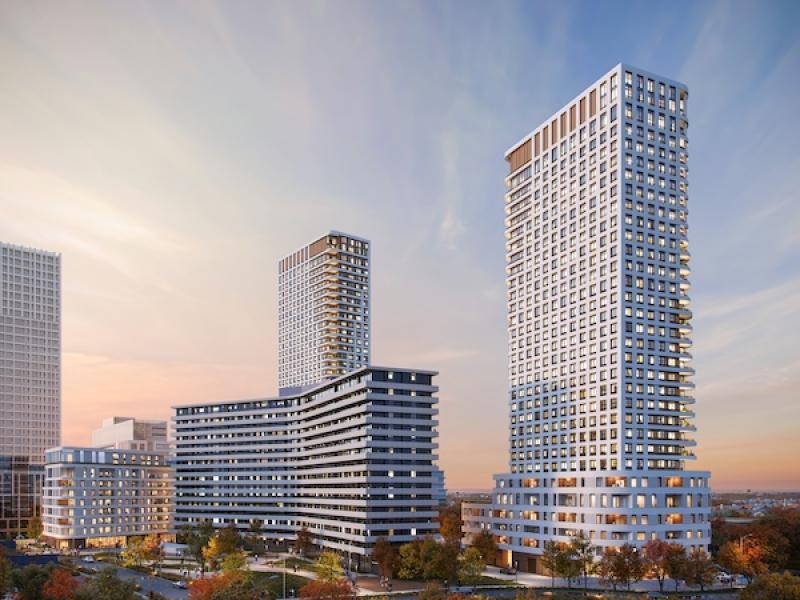The Bathurst Street corridor in North York is undergoing a dramatic facelift in a race against time to build housing as Toronto’s population continues to rapidly expand.
Toronto developer Tenblock is front and centre in the makeover with a plan to add three towers and 892 new housing units at 155 Antibes Dr.
True to its development philosophy, Tenblock is planning to redevelop the property with three buildings in such a way that locals can enjoy a taste of arcadia in an urban environment. The first will be the largest at 34 storeys and containing 432 units; the second 355-unit building will be 30 storeys; and the third is an eight-storey mid-rise building with 105 units.
The site has an existing 259-unit, 16-storey purpose-built rental building from the 1970s, which will remain.
“With Toronto growing, we saw a great opportunity for us to introduce new housing and improve public land with landscaping,” Dan Kwak, development manager at Tenblock, told RENX. “We have an 870-square-foot ‘pop space,’ which will be a hub where you can grab a bike share.
“It’s a large public space with trees, a bike station and visitor bike parking that we like to call a transit cycling hub,” Kwak added of the urban greenery that will also include a patio lounge area.
Change afoot in North York
Tenblock has yet to decide whether 155 Antibes will be constructed as a condo or purpose-built rental project and is also considering partnering with other builders.
Located between Steeles and Finch, it is in an area rich with multiresidential development. It is joined to the northwest by Greatwise Developments’ condo development at 5950 Bathurst and Novi Properties’ 25 Cedarcroft Blvd. on the northeastern corner.
The area is a growth hub, as mandated by the Places to Grow Act of 2005, and has swift access to downtown Toronto in around half an hour thanks to public transit.
However, while growth presents an opportunity, a tempered pace is imperative.
Kwak quickly credited Toronto municipal government city planner Marty Rokos and urban designer Kaari Kitawi for helping Tenblock amend its original proposal to a final product that is most suitable for the neighbourhood.
The amendments led to designing what Kwak called “a more harmonious” built environment, which lined up nicely with Tenblock’s sustainable building ethos.
“We have a more socially and environmentally responsive development style,” Kwak said. “We’re pushing hard and trying to support and promote cycling in different ways for transportation.
“In many of our projects we work with the Toronto biking authority to implement biking systems on our sites. We’re looking to expand how we circle and get around the area, and we’re looking to improve on the design of bike parking.”
A pop-up space between Towers A and B on the east side of the site will be extensively landscaped as an expanse of green space and trees with a bike station that includes visitor bike parking. Tenblock refers to the area as a cycling transit hub that features a bike share.
Although no decisions have yet been made, Tenblock is considering including a geo-exchange program, as well as other enhancements, in the three towers it’s adding to the site.
Infill sites are key to growth
Tenblock focuses on infill sites where it can increase housing density and, considering that it has eight different projects on the go, there seems to be no shortage of such properties.
145 St. George Street in downtown Toronto is one such development, receiving approval from Toronto council in July.
Located off Bloor Street, the 30-storey tower with 398-units — of which 130 are rental replacements — is located within 10 minutes of several TTC stops and a stone’s throw from the University of Toronto’s main campus.
5 Capri is another development with 805 units spread across two 22-storey buildings connected by a podium. The project received approval from Etobicoke’s community council a few weeks ago.
Toronto’s dearth of land means redeveloping existing sites is most likely how the city will achieve housing and supply equilibrium – if that is ever to actually happen.
“We’re trying to tap into these great opportunities to create housing on sites that are outdated or where there’s opportunity to do an infill property,” Kwak said.

